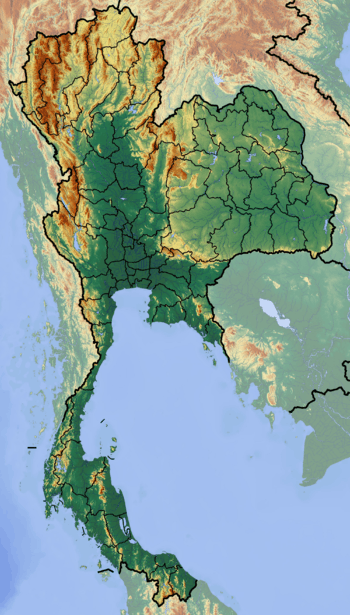Khao Laem Ya–Mu Ko Samet National Park
Khao Laem Ya–Mu Ko Samet (Thai: เขาแหลมหญ้า-หมู่เกาะเสม็ด) is a Thai marine national park in the Gulf of Thailand off the coastline of Rayong, approximately 180 km southeast of Bangkok.[1][2]
| Khao Laem Ya–Mu Ko Samet National Park | |
|---|---|
| เขาแหลมหญ้า-หมู่เกาะเสม็ด | |
IUCN category II (national park) | |
West coast of Ko Samet | |
 Park location in Thailand | |
| Location | Rayong Province, Thailand |
| Nearest city | Rayong |
| Coordinates | 12°35′27″N 101°25′01″E |
| Area | 131 km2 (51 sq mi) |
| Established | 1981 |
| Governing body | Department of National Parks, Wildlife and Plant Conservation |
In 1981, the Royal Forest Department declared the archipelago of Ko Samet, along with nine other small islands, the headland of Khao Laem Ya, and the 11 kilometre Mae Rampeung Beach to be a national park, and thus these areas are under the jurisdiction of the national parks department. In August 2013 more than 500 national park officials were deployed to destroy three resorts—Muk Samet, Unseen, and Ploy Samet—which had been built illegally in the park.
Geography
The park covers an area of 131 square kilometres of land and sea in Mueang Rayong District (Thai: เมืองระยอง), Rayong Province. The major and minor landmarks of the park are:
- Khao Plet (Plet Hill and valley)
- Khao Laem Ya (Leam Ya Hill and valley)
- Mae Ram Phung Beach and mountain
and the islands of:
- Ko Samet
- Ko Kudi (Monk's Chamber Island)
- Ko Kruai (Cone Island)
- Ko Makham (Tamarind Island, also called Ko Kham)
- Ko Plai Tin (Foot's Tip Island)
- Ko Chan (Moon Island)
- Ko Talu (Hole Island)
- Ko Klet Chalam (Shark Scale Island)
- Ko Thai Khang Kao (Bat's Bottom Island)
Fauna
Fish in the waters around the islands include Parrot fish, blue damselfish and Cuttlefish are also found.[3]:46 Mammals include Crab-eating macaque, Lesser mouse-deer and Flying foxes are also found here.[3]:46 The islands are home to the following seabirds Pacific reef heron, Black-naped tern, Bridled tern, Great crested tern and Roseate tern.[3]:46 Other birds in the park include Blue-winged pitta, Zebra dove, Coppersmith barbet and Asian barred owlet.[3]:47
Park corruption
In September 2016, the park chief and 79 other officials were removed from their posts for corruption. Investigations found that 200,000 baht per month was paid to park officials as kickbacks. The Department of National Parks (DNP) found that all businesses on Ko Samet "valued at over 100 million baht per month" were operated by "mafia groups", some linked to police officers. Since the removal of corrupt officials, revenues at the park have increased, rising to 4.8 million baht in October 2016, compared with 1.2 million baht in October 2015.[4]
References
- "Khao Laem Ya-Mu Ko Samet National Park". Bangkok Post. n.d. Retrieved 18 November 2016.
- "KHAO LAEM YA - MU KO SAMET NATIONAL PARK". Tourism Authority of Thailand (TAT). Retrieved 18 November 2016.
- Elliot, Stephan; Cubitt, Gerald (2001). THE NATIONAL PARKS and other Wild Places of Thailand. New Holland Publishers (UK) Ltd. ISBN 9781859748862.
- Wipatayotin, Apinya (18 November 2016). "Samet beset by graft, probe finds". Bangkok Post. Retrieved 18 November 2016.